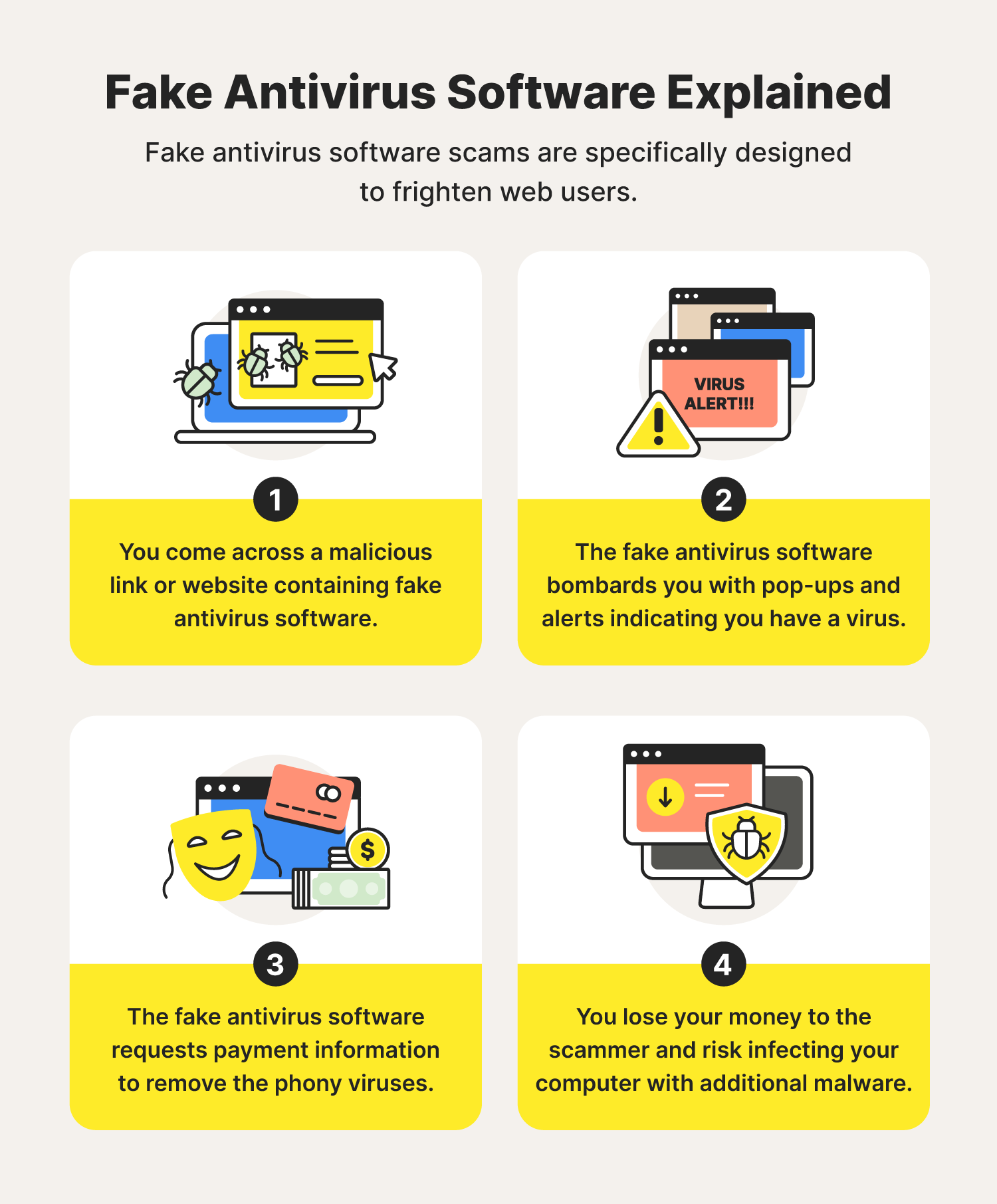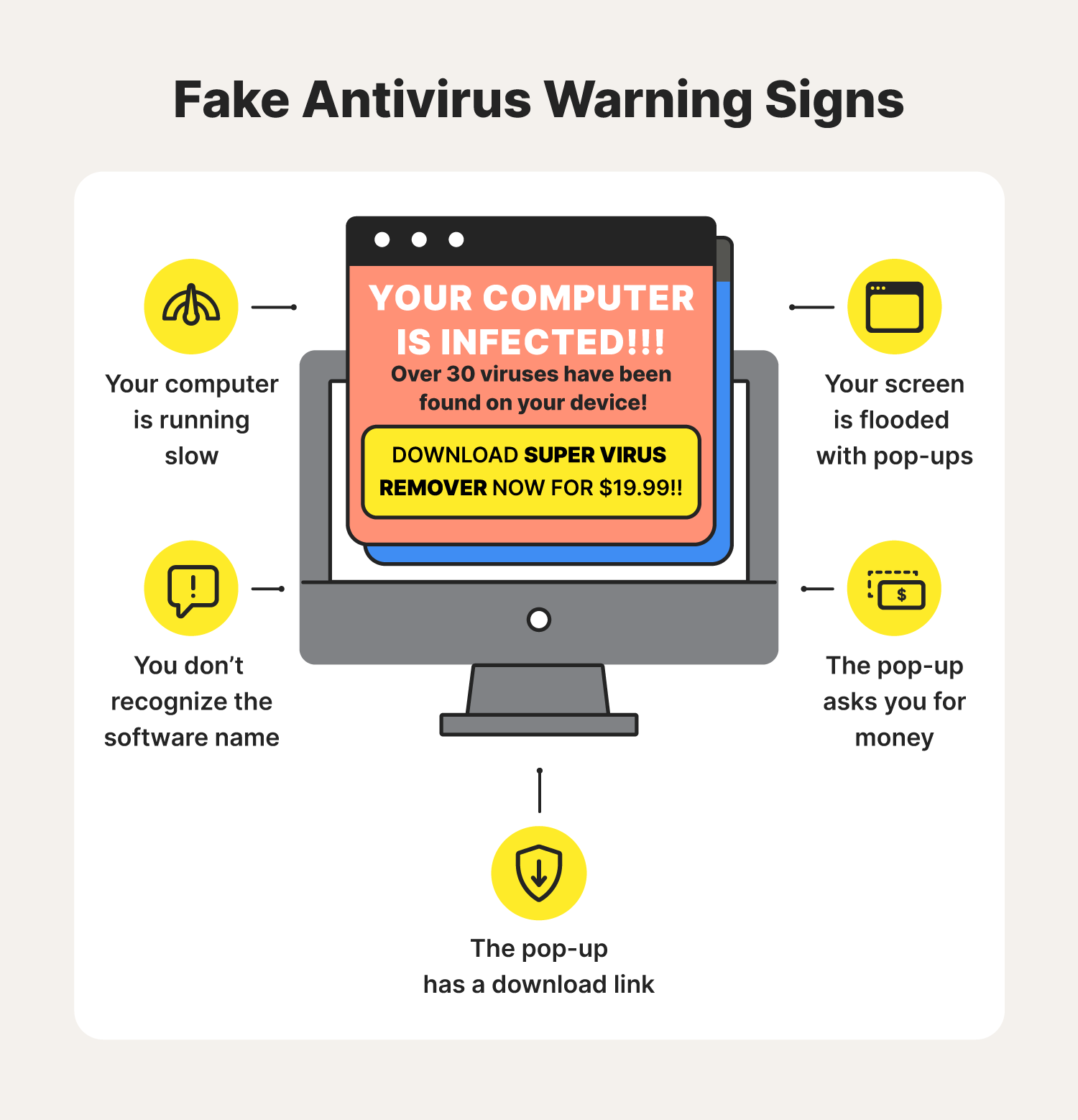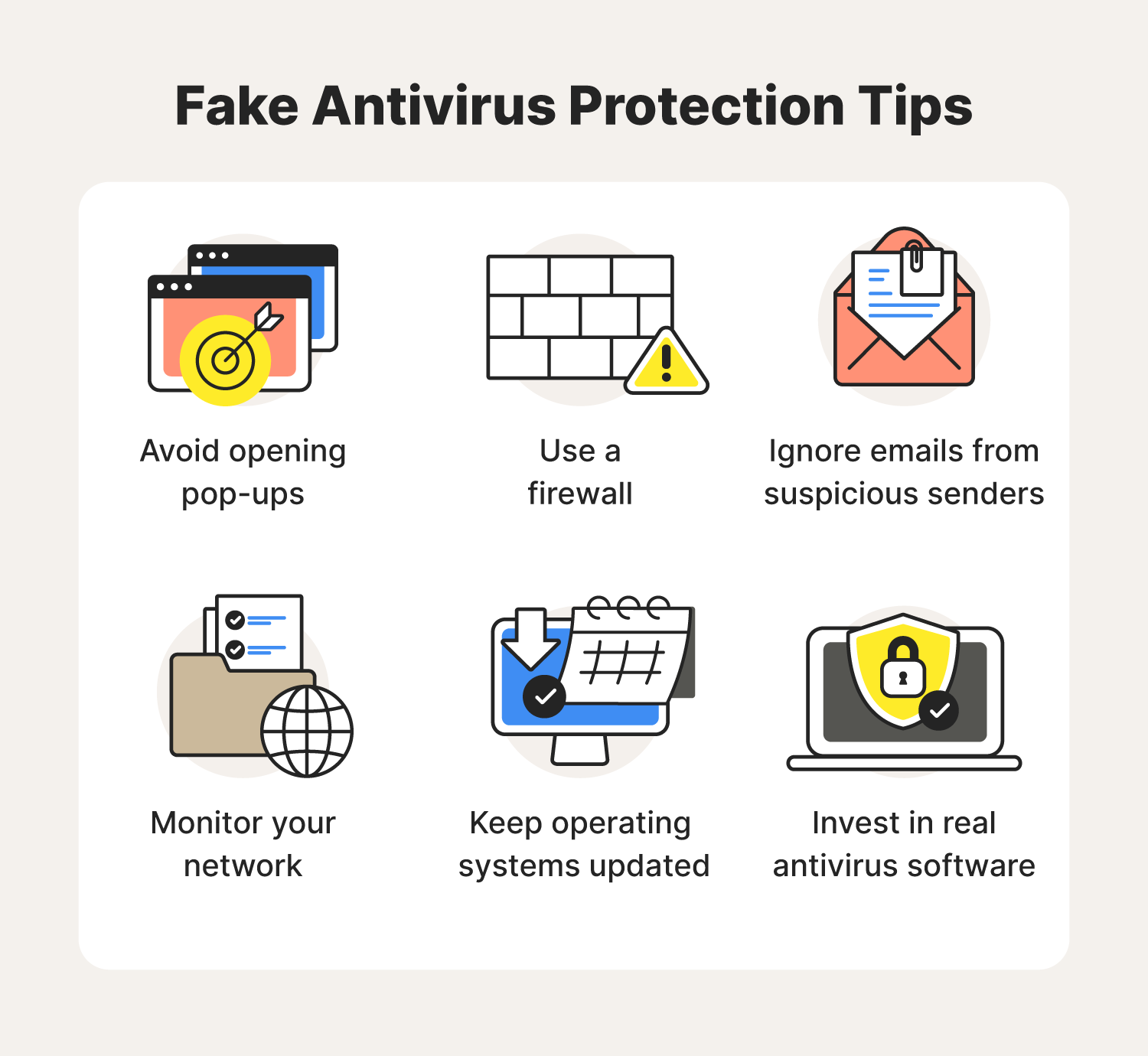What is a fake antivirus software? An overview of rogue security software
What is fake antivirus software? Follow this guide to learn more and discover helpful tips on how to spot and avoid fake antivirus scams online.

Have you ever been surfing the web and come across a warning alerting you that you have a virus? While this may seem alarming, it could be fake antivirus software.
But what is fake antivirus software? Also known as rogue antivirus, fake antispyware, or smitfraud, fake antivirus software is malware that imitates real antivirus software by running phony security scans and displaying fake computer virus warnings on your device.
Scammers design these warnings specifically to scare you. After convincing you that your computer is riddled with nonexistent viruses, the fake antivirus will offer to remove them for a price. In addition to losing your money to a scammer, the fake antivirus software could also be a Trojan or spyware, which are other dangerous threats to your computer.
To help protect your computer from the sneaky scammers of the internet, continue reading to learn more about how you can detect, remove, and avoid fake antivirus software.
How can my computer become infected with fake antivirus?

You can come across a fake antivirus scam almost anywhere. Oftentimes cybercriminals will distribute this dangerous malware through:
- Social media sites
- Unwanted internet advertisements
- Search engines
- Emails
- Other types of malware
When cybercriminals design these cyberattacks, they attempt to manipulate you through social engineering tactics, hoping you’ll reveal sensitive information or give up your hard-earned money.
To decrease your chances of coming across a fake antivirus scam, it’s best to always think before you click and stay on safe websites.
How to detect fake antivirus scams

Now that you know that bogus antivirus warnings exist, how can you determine whether a virus warning is real or fake? As you browse the web, keep an eye out for these warning signs:
- Unrecognizable antivirus software: If you see a virus warning, ask yourself if it looks like the antivirus software you normally use. If not, this is a major red flag. If you notice the alert is coming from antivirus software that you never installed, you’re likely dealing with a fake virus scam and shouldn’t interact with the warning.
- Inoperable antivirus programs: Unlike trusted antivirus software, most phony virus alerts are fake applications that produce a pop-up window linking to a fake antivirus download or a payment link.
- Frequent antivirus alerts and pop-ups: To induce your natural response of fear and anxiety, fake antivirus software will include frequent pop-ups. Scammers implement this tactic to rush you into paying them, accidentally downloading more malware, or both.
- Suspicious links and attachments: As with any pop-up or website, you should be wary of suspicious links and attachments. Although it may seem natural to quickly click on something claiming to help protect your computer, you’ll be better off by avoiding any links in the pop-up.
- Requests for money: If the virus alert includes a request for payment, it's likely you’re dealing with fake antivirus software. To be safe, never give your payment information to any unfamiliar websites.
- System freezes and slower speeds: If the phony antivirus software is accompanied by slow speeds or system freezes, you could be dealing with a scam. These fake viruses may also include animations that make it seem as if your computer is crashing. This is another tactic used to make you think your computer has a virus.
- Browser hijacking: When dealing with fake antivirus software, you may notice random changes happening within your web browser. Common examples include changes to your homepage or newly installed toolbars. If you experience this, it’s likely that the virus alert is a result of a fake antivirus scam.
By keeping these red flags top of mind when you’re online, you’ll greatly reduce the risk of mistaking a fake antivirus scam for an actual issue with your computer.
How to remove fake antivirus software
Once you’ve determined you’re dealing with fake antivirus software, there are different ways to remove malware from your device. In a perfect world, you’d immediately know exactly how the fake antivirus was built, and then use the removal method that works best for that specific malware.
Because that isn’t always the case, there is one solution that should have your computer back up and running in no time. You can do it by:
- Formatting your har
- Reinstalling your operating system
- Redownloading your backed-up files and programs
It's important to note that this method will only work if you have a backup of all of your files. If not, you may end up permanently losing them. Although this may seem inconvenient, you’ll be left with a clean system and no trace of the fake antivirus software.
How to avoid fake antivirus software

Luckily, there are many steps you can take to avoid coming into contact with fake antivirus software. The next time you’re surfing the web, keep these tips in mind to help protect yourself online.
- Avoid opening pop-ups: If you come across a pop-up, it’s best to immediately close the window. Clicking on a pop-up can put you and your personal information at risk.
- Use a smart firewall: All popular operating systems come with a built-in firewall. To ensure you’re browsing the internet as safely as possible, it's best to enable it.
- Ignore emails from suspicious senders: 75% of cyberattacks start with an email. If you receive an email from someone you don’t know, it’s best to avoid opening it or any attachments.
- Monitor your network: To avoid any potential threats, it is important to monitor and secure your network. With an unsecured network, cybercriminals can easily access your personal information and spam your devices with malware.
- Keep operating systems updated: To ensure your information is protected, it's crucial to stay on top of any software updates your device may need. Be sure to also keep your web browser up to date.
- Invest in real antivirus software: For maximum protection against fake antivirus software, you can download a trustworthy antivirus program. Not only will this protect you from fake virus alerts, but also dangerous malware, viruses, spyware, and other cyberattacks. Investing in antivirus software for Windows 10 and Windows 11 can provide an additional layer of protection.
By taking steps to prioritize your cybersecurity, you can go back to cruising the internet with confidence, sure that you’ve left no doors open for cybercriminals to sneak through.

Cyber threats have evolved, and so have we.
Norton 360™ with LifeLock™, all-in-one, comprehensive protection against viruses, malware, identity theft, online tracking and much, much more.
Try Norton 360 with Lifelock.
Editorial note: Our articles provide educational information for you. Our offerings may not cover or protect against every type of crime, fraud, or threat we write about. Our goal is to increase awareness about Cyber Safety. Please review complete Terms during enrollment or setup. Remember that no one can prevent all identity theft or cybercrime, and that LifeLock does not monitor all transactions at all businesses. The Norton and LifeLock brands are part of Gen Digital Inc.





Want more?
Follow us for all the latest news, tips and updates.